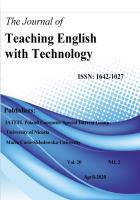CYBERBULLYING AMONG EFL STUDENTS’ BLOGGING ACTIVITIES: MOTIVES AND PROPOSED SOLUTIONS
CYBERBULLYING AMONG EFL STUDENTS’ BLOGGING ACTIVITIES: MOTIVES AND PROPOSED SOLUTIONS
Author(s): Hamuddin Budianto, Fathu Rahman, Abidin Pammu, Yusring Sanusi Baso, Tatum DerinSubject(s): Foreign languages learning
Published by: IATEFL Poland Computer Special Interest Group and The University of Nicosia
Keywords: cyberbullying; motives; solutions; linguistic wordplay; blogs
Summary/Abstract: Cyberbullying during English teaching involving Information Communication Technology (ICT) is an exciting topic to study. Seeing how new language learners share their thoughts and feelings through blogs as alternative learning media and how they engage in cyberbullying in their online interactions may reveal the motives beyond cyberbullying acts. This present study used the mixed method approach to understand the motives to tailor the anti-cyberbullying recommended solutions. The data is extended from a 3-month preliminary study to an 18-month investigation of 711 cyberbullying comments archived in 251 blogs owned and actively used by EFL university students at English Department of Universitas Lancang Kuning (Unilak). The analysis revealed the major students’ motive is just to have fun (70%), followed far behind by the motive to fight back (8%), to express upset feelings (7%), and other motives (12%). 16 students with the highest track record of cyberbullying in their blogging activities were interviewed to discuss their motives for cyberbullying other students whom they have known for at least more than 18 months. Results indicate cyberbullying among language learners seems to be an act of playing with language or linguistics wordplay. Cyberbullying seems to be a sort of language exaggeration for EFL students who possess limited competence in English when they interact in the online network. Based on the results, a new definition of cyberbullying was offered to accommodate the linguistic nature of cyberbullying. Using the primary health care framework by the World Health Organization (WHO), this present study designed a practical list of ready-made classroom activities to combat cyberbullying in four different steps, i.e. promotive, preventive, curative and rehabilitative.
Journal: Teaching English with Technology
- Issue Year: 20/2020
- Issue No: 2
- Page Range: 3-20
- Page Count: 18
- Language: English

